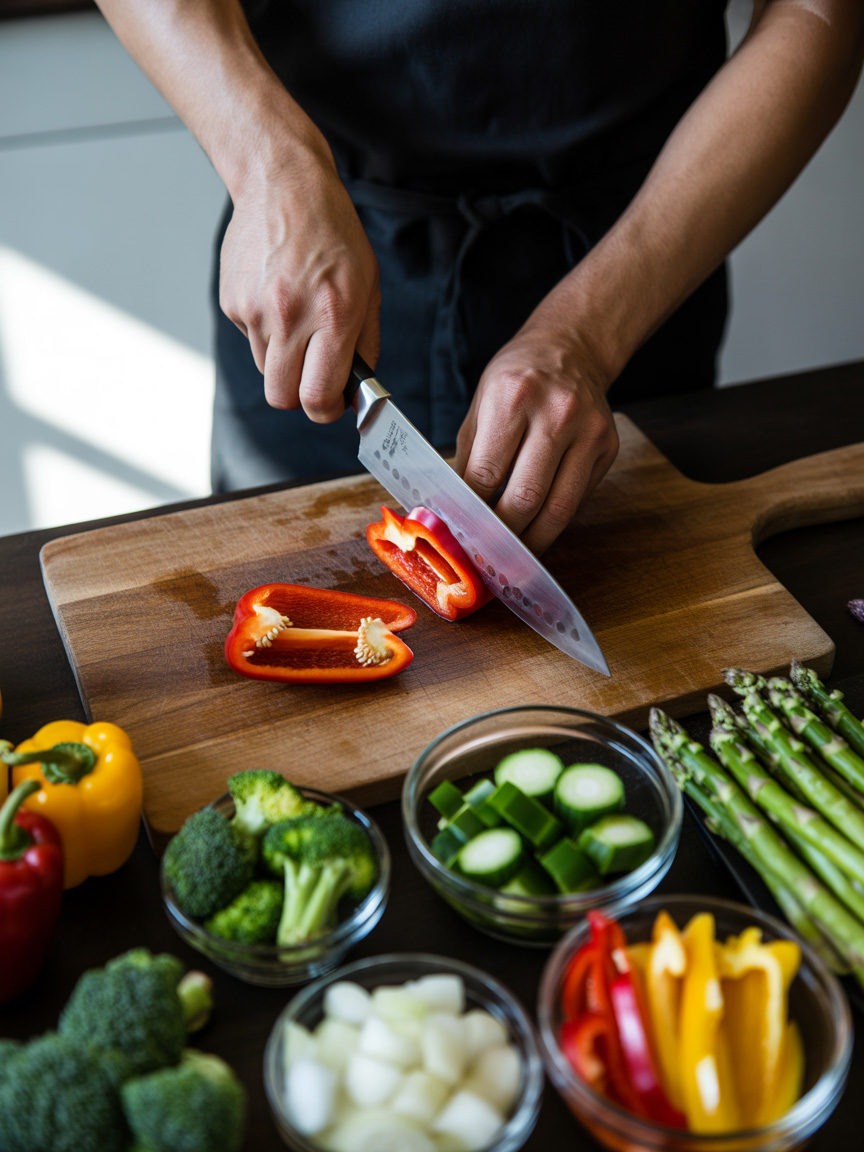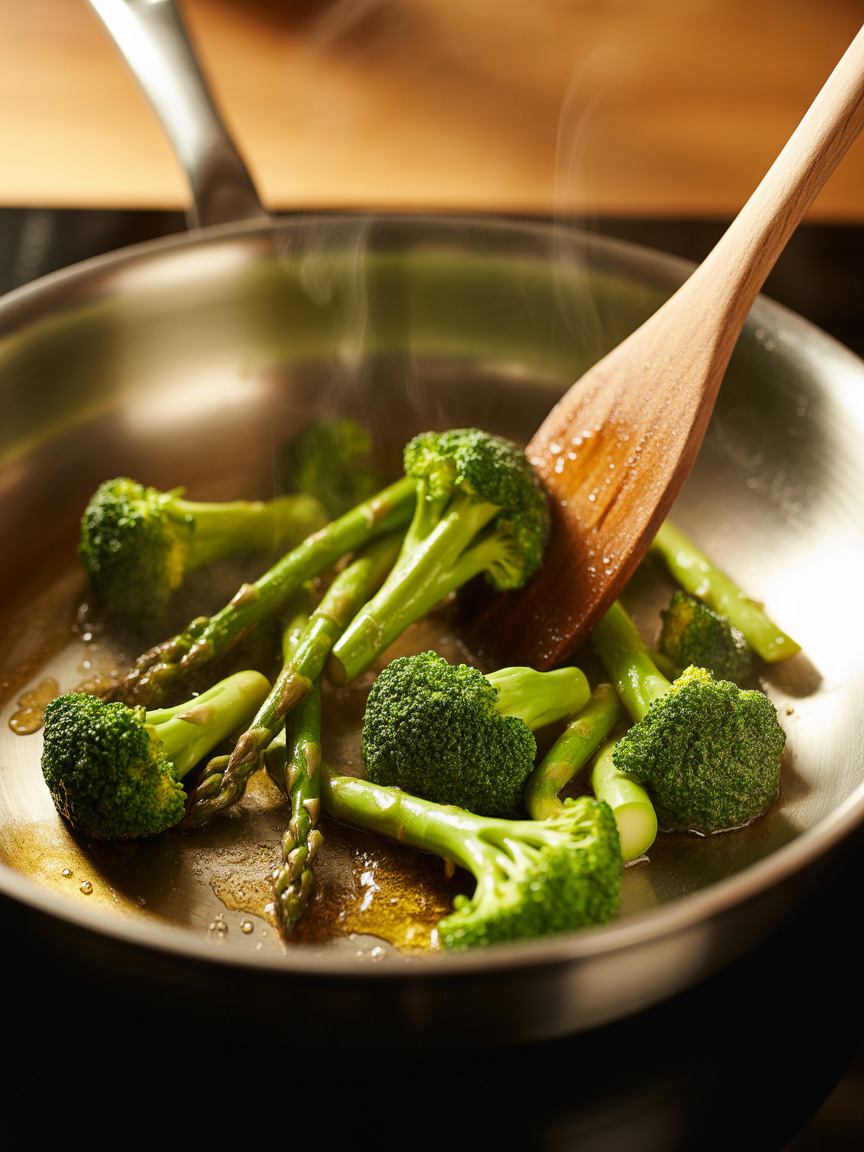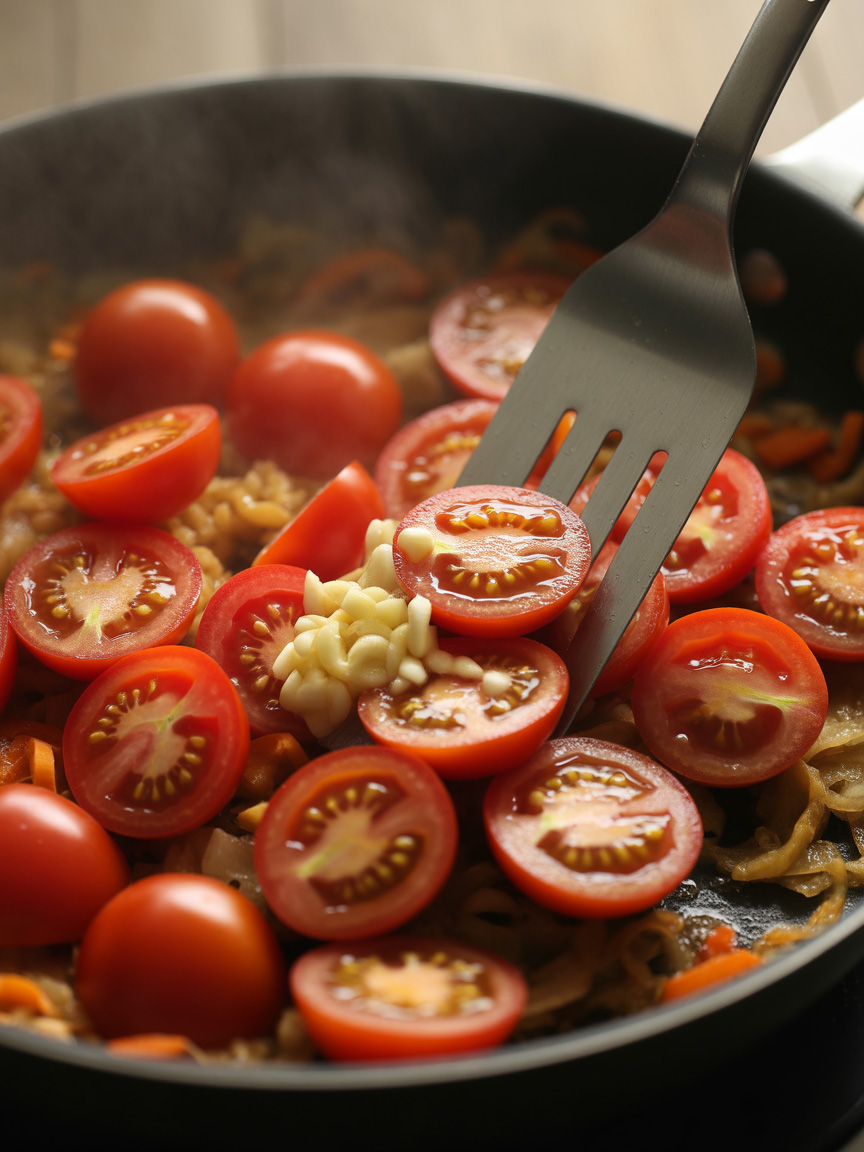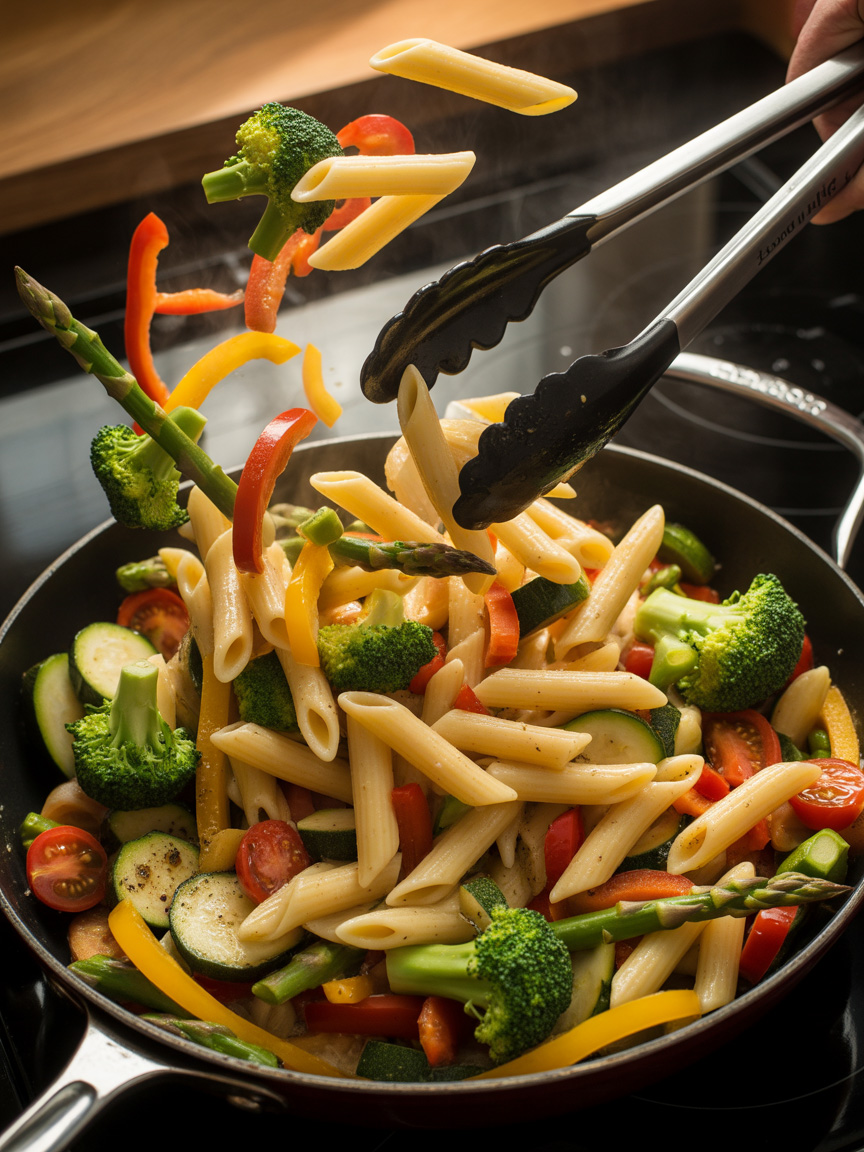There’s something magical about a big bowl of pasta loaded with colorful, fresh vegetables. This Pasta Primavera is exactly that – a celebration of fresh produce tossed with perfectly cooked pasta in a light garlic butter sauce. It’s the kind of meal that makes you feel good while you’re eating it, knowing you’re getting tons of vegetables without it tasting like diet food.
The name “primavera” means “spring” in Italian, and this dish is all about showcasing whatever fresh vegetables are in season. Bright cherry tomatoes, crisp asparagus, sweet bell peppers, tender zucchini, vibrant broccoli – it all comes together in a light sauce that lets the vegetables shine. Add some parmesan cheese and fresh herbs, and you’ve got a restaurant-quality meal that takes about 30 minutes from start to finish.
I started making this recipe during those times when I had a fridge full of random vegetables that needed using up. Instead of letting them go to waste, I’d throw them all into pasta and it always turned out amazing. The beauty of Pasta Primavera is its flexibility – you can use whatever vegetables you have or whatever looks good at the market. It’s one of those forgiving recipes that adapts to what you’ve got.
Whether you’re trying to eat more vegetables, looking for a lighter pasta option, need to use up produce before it goes bad, or just want something fresh and delicious, this Pasta Primavera is about to become your go-to. It’s healthy without being boring, satisfying without being heavy, and colorful enough to make everyone at the table smile.
Why This Pasta Primavera is Absolutely Perfect
I’ve made countless pasta dishes over the years, and this Pasta Primavera consistently delivers on every level. Here’s why it’s so incredibly good.
Fresh and Light Yet Satisfying
This isn’t a heavy, cream-laden pasta that leaves you feeling sluggish. The sauce is light – just olive oil, butter, garlic, a splash of pasta water, and fresh lemon juice. But here’s the thing – it doesn’t feel light or unsatisfying. The vegetables add substance, the pasta provides comfort, and the parmesan brings richness. You end up with a meal that’s genuinely nourishing and leaves you feeling energized rather than weighed down. It’s the kind of dinner you can eat and still feel good about yourself afterward.
Packed with Vegetables
Let’s be real – most of us don’t eat enough vegetables. This recipe sneaks in a massive amount without it feeling like you’re forcing yourself to eat healthy. You’re getting bell peppers, zucchini, cherry tomatoes, broccoli, asparagus – that’s like five servings of vegetables in one meal. And because they’re sautéed with garlic and tossed with pasta, they actually taste delicious instead of like something you’re obligated to eat. IMO, this is the best way to get vegetables into picky eaters or anyone who claims they don’t like veggies.
Quick and Simple
Thirty minutes. That’s all you need. The pasta cooks while you prep and sauté the vegetables, and everything comes together in one pan at the end. There’s no complicated technique, no long ingredient list of obscure items, no advanced cooking skills required. It’s straightforward cooking that anyone can master. Perfect for busy weeknights when you want something healthy but don’t have time for anything elaborate.
Budget-Friendly and Flexible
Pasta is cheap. Vegetables are affordable, especially when you buy what’s in season or on sale. A box of pasta, whatever veggies you have, some garlic, olive oil, and parmesan – you’re looking at a dinner for four that costs under fifteen bucks. Plus, this recipe is incredibly forgiving and flexible. Don’t have asparagus? Leave it out or use green beans. No cherry tomatoes? Use diced regular tomatoes or skip them entirely. Got extra mushrooms or spinach? Throw them in. The recipe adapts to whatever you have, which means less food waste and more variety every time you make it.
Your Simple Ingredient Checklist
The ingredient list looks long because of all the vegetables, but everything here is simple and easy to find. Use this as a guide, but feel free to swap vegetables based on what you have or what’s in season.
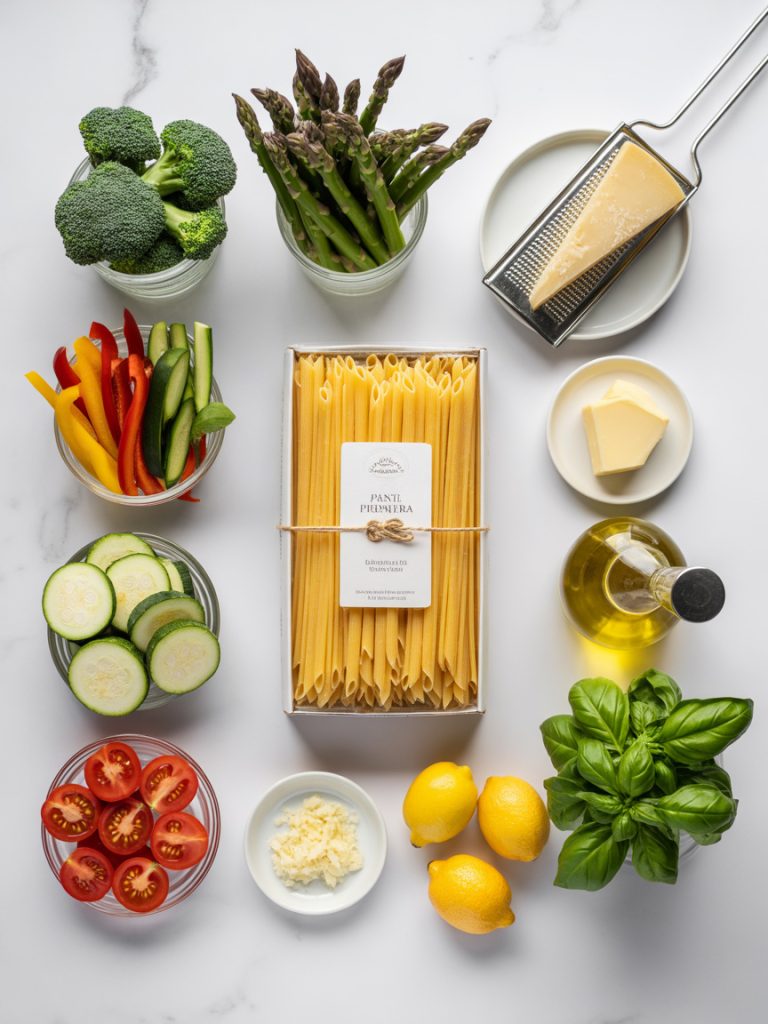
The Ingredient Lineup:
For the Pasta:
- 1 pound pasta (penne, fusilli, farfalle, or spaghetti)
- Salt for pasta water
For the Vegetables:
- 2 tablespoons olive oil
- 2 tablespoons butter
- 1 cup broccoli florets
- 1 cup asparagus (cut into 1-inch pieces)
- 1 red bell pepper (sliced into strips)
- 1 yellow bell pepper (sliced into strips)
- 1 medium zucchini (halved and sliced)
- 1 cup cherry tomatoes (halved)
- 3 cloves garlic (minced)
- ½ cup reserved pasta water
- 2 tablespoons fresh lemon juice
- ½ cup grated parmesan cheese
- ¼ cup fresh basil (chopped)
- Salt and black pepper to taste
- Red pepper flakes (optional, for heat)
Optional Add-ins:
- Frozen peas
- Snap peas
- Mushrooms
- Spinach or arugula
- Sun-dried tomatoes
- Pine nuts
- Fresh parsley
Ingredient Tips and Substitutions:
Pasta: Any pasta shape works here. Short shapes like penne, fusilli, or farfalle are great because they catch the vegetables. Long pasta like spaghetti or linguine works too – just a different eating experience. Whole wheat pasta adds fiber and nutrients. For gluten-free, use your favorite GF pasta and follow package directions since cooking times vary.
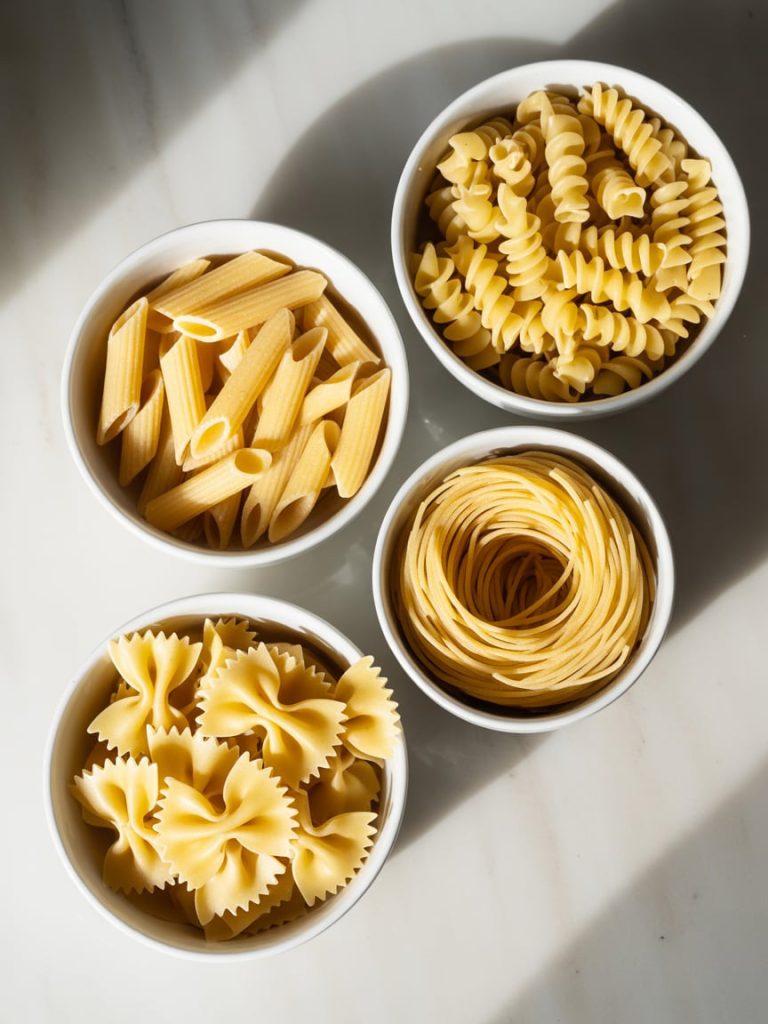
Vegetables: This is where you can really customize. The vegetables I’ve listed are classic primavera choices, but use whatever you have or whatever looks good at the store. Spring vegetables like asparagus, peas, and baby carrots are traditional. Summer vegetables like zucchini, bell peppers, and tomatoes are perfect. Even winter vegetables like cauliflower or Brussels sprouts work if you cut them small. The key is cutting everything into similar-sized pieces so they cook evenly.
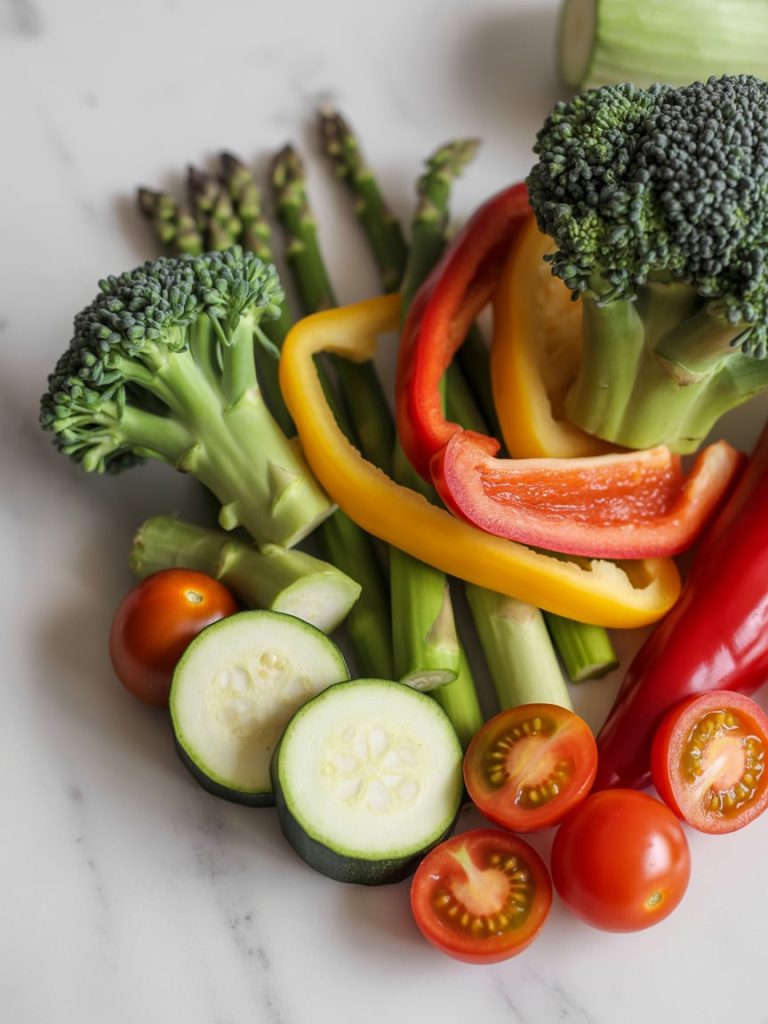
Broccoli and Asparagus: These are hearty vegetables that need a few minutes to cook. If your asparagus is thick, cut it into smaller pieces. Tender asparagus can be left in larger pieces. Broccoli should be broken into small florets. Both can be blanched briefly if you prefer them more tender.
Bell Peppers: Use whatever color you like or have available. Red, yellow, and orange are sweeter. Green is more vegetal and slightly bitter. A mix of colors makes the dish more visually appealing. If you don’t like bell peppers, skip them or use something else.
Zucchini: Summer squash or yellow squash work equally well. Cut them into half-moons so they cook quickly and don’t turn mushy. If your zucchini is very watery or seedy, you might want to salt it lightly and let it drain for a few minutes before cooking.
Cherry Tomatoes: These add pops of sweetness and acidity that brighten the whole dish. Grape tomatoes work too. If you only have regular tomatoes, dice them, but they’ll be more watery. Sun-dried tomatoes (drained and chopped) add a completely different but delicious flavor.
Garlic: Fresh garlic is essential for that aromatic base flavor. Three cloves is moderate – add more if you’re a garlic lover, or reduce if you’re more sensitive to it. Don’t let the garlic burn or it’ll turn bitter.
Olive Oil and Butter: The combination gives you the best of both worlds – olive oil can handle higher heat, while butter adds richness and flavor. You can use all olive oil for dairy-free, or all butter if you prefer. Just adjust cooking heat accordingly since butter burns easier than oil.
Parmesan Cheese: Freshly grated parmesan is best – it melts smoothly and has better flavor than pre-grated. For vegetarians, make sure your parmesan is made with vegetarian rennet. For vegan, use nutritional yeast or skip the cheese and add more lemon juice and herbs for flavor.
Fresh Herbs: Basil is classic with Italian food and tastes amazing here. Fresh parsley works too. Dried herbs won’t give you that same bright, fresh flavor, so if you don’t have fresh herbs, just rely on the lemon juice for brightness.
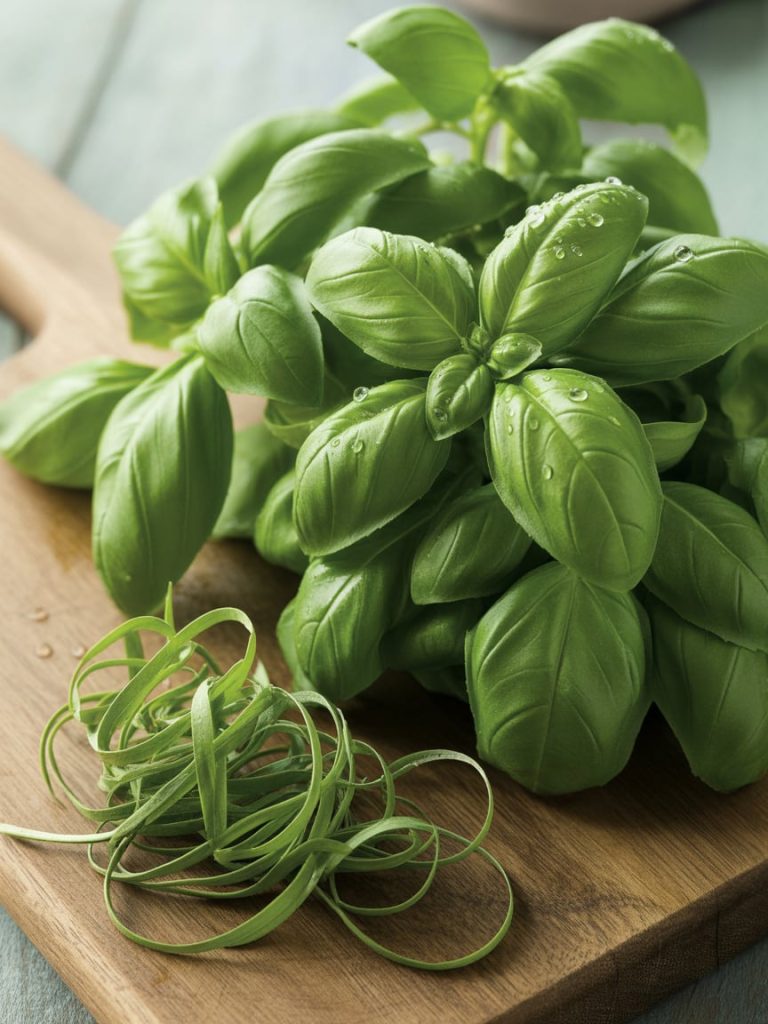
Lemon Juice: Fresh lemon juice adds brightness and acidity that balances the richness of the butter and cheese. It’s what makes this dish taste fresh and light instead of heavy. Don’t skip it – it’s essential.
Step-by-Step Cooking Instructions
Alright, let’s make this beautiful Pasta Primavera. The key is having everything prepped before you start cooking because once you begin, things move quickly.
Part 1: Cook the Pasta and Prep the Vegetables
Prep All Your Vegetables: Before you start cooking anything, wash and cut all your vegetables. Broccoli into small florets, asparagus into 1-inch pieces, bell peppers into strips, zucchini into half-moons, cherry tomatoes halved, garlic minced. Have everything ready in bowls or on your cutting board so you can add them to the pan in the right order. This mise en place approach makes the actual cooking smooth and stress-free.
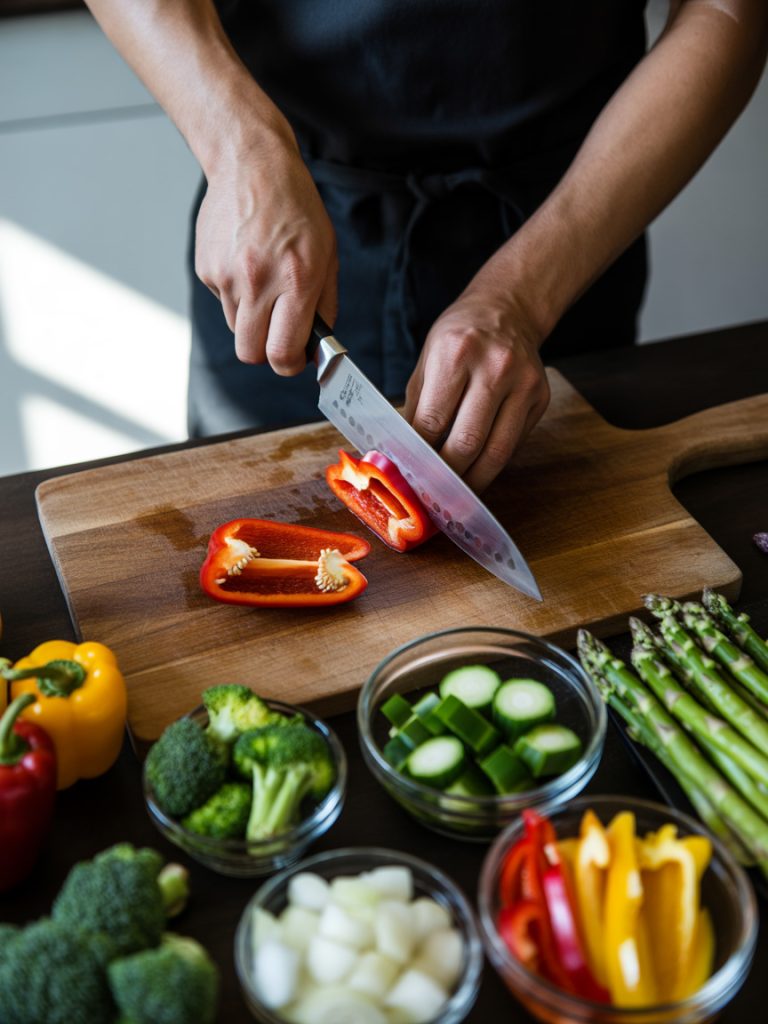
Boil the Pasta Water: Fill a large pot with water and add a generous amount of salt – about 1-2 tablespoons. The water should taste like the ocean. Bring to a rolling boil over high heat. This takes about 10 minutes, which gives you time to prep vegetables if you haven’t already.
Cook the Pasta: Once boiling, add your pasta and cook according to package directions until al dente. This usually takes 8-12 minutes depending on the shape. You want it cooked through but still with a slight bite – it shouldn’t be mushy. Stir occasionally to prevent sticking.
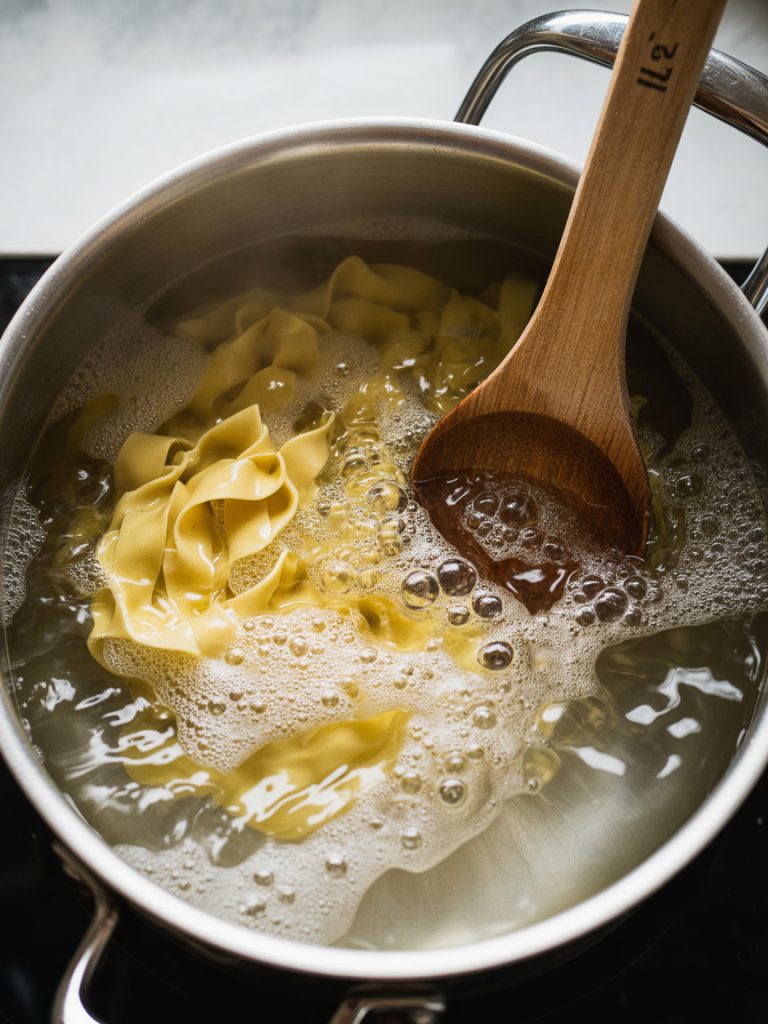
Reserve Pasta Water: Before draining, scoop out about 1 cup of the starchy pasta water with a measuring cup. This is important – don’t skip this step. That starchy water helps create a sauce that clings to the pasta and vegetables. Set it aside.
Drain the Pasta: Drain the pasta in a colander but don’t rinse it. You want that starchy coating to help the sauce stick. Give it a shake to remove excess water and set aside.
Part 2: Sauté Vegetables and Combine
Start with Harder Vegetables: While your pasta is cooking (or right after draining), heat the olive oil and butter in a large skillet or wok over medium-high heat. Once the butter melts and starts to foam, add the broccoli and asparagus first – these are the vegetables that take longest to cook. Sauté for about 4-5 minutes, stirring occasionally, until they’re crisp-tender and starting to get some golden color on the edges.
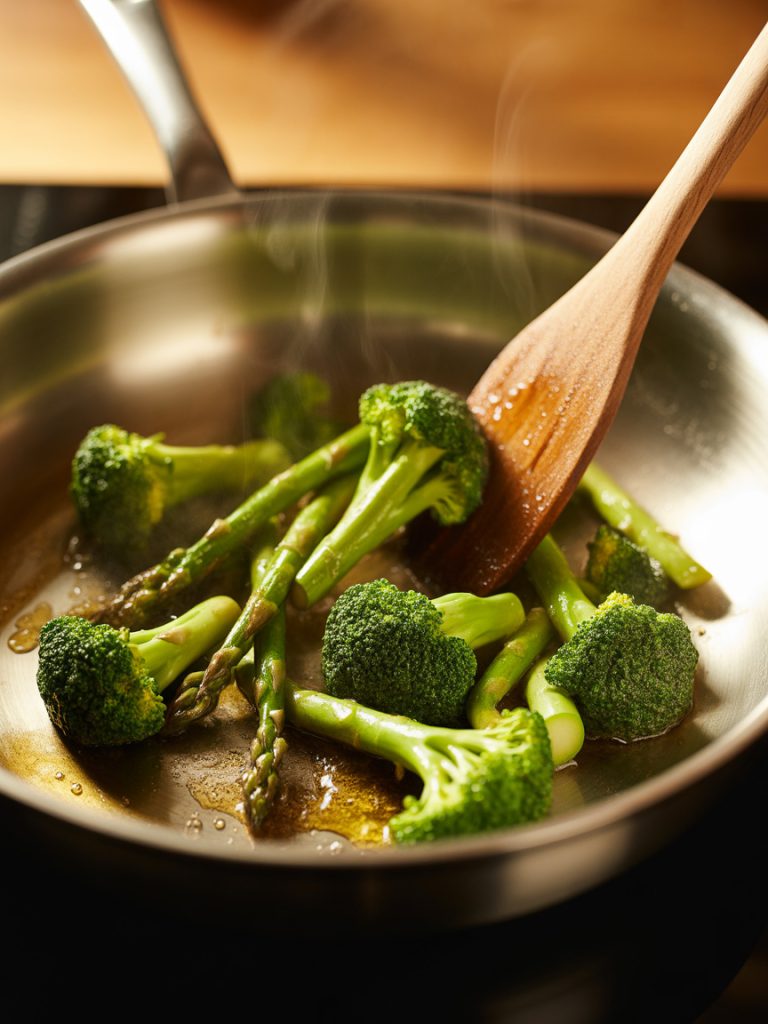
Add Medium-Cooking Vegetables: Add the sliced bell peppers and zucchini to the pan. Continue cooking for another 3-4 minutes, stirring frequently. The peppers should soften slightly but still have some crunch, and the zucchini should be tender but not mushy. You want everything cooked but still with texture and color.
Add Garlic and Tomatoes: Reduce heat to medium. Add the minced garlic and halved cherry tomatoes. Cook for about 2 minutes, stirring constantly so the garlic doesn’t burn. The tomatoes should just start to soften and release some juice, but they shouldn’t completely break down. The garlic should be fragrant and golden.
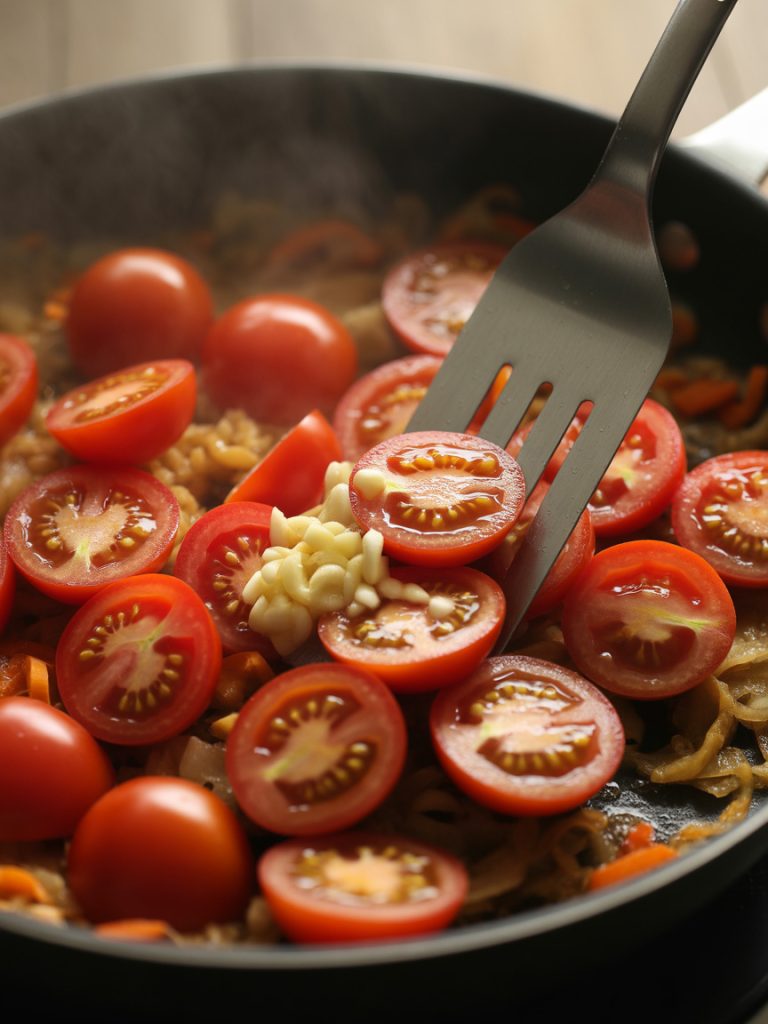
Create the Sauce: Add about ½ cup of the reserved pasta water to the vegetables. The water will bubble up and create steam – that’s good. It helps cook the vegetables a bit more and creates a light sauce. Add the lemon juice and stir everything together. Let it simmer for about 1 minute. Season with salt, black pepper, and red pepper flakes if using. Taste and adjust seasoning – you might need more salt or lemon.
Combine Pasta and Vegetables: Add the drained pasta directly to the skillet with the vegetables. Toss everything together using tongs or two large spoons. Make sure the pasta gets coated with the sauce and the vegetables are distributed evenly throughout. If the mixture looks dry, add more pasta water a little at a time until you get a light, glossy coating. The pasta should be well-coated but not swimming in liquid.

Add Cheese and Herbs: Turn off the heat. Add the grated parmesan cheese and fresh basil. Toss everything together one more time. The residual heat will melt the cheese slightly and wilt the basil, releasing its aroma. Give it a final taste and adjust seasoning if needed.
Serve Immediately: Transfer to a large serving bowl or individual bowls. Top with extra parmesan cheese, fresh basil, and a drizzle of good olive oil if you’re feeling fancy. Serve while hot with extra parmesan on the side.
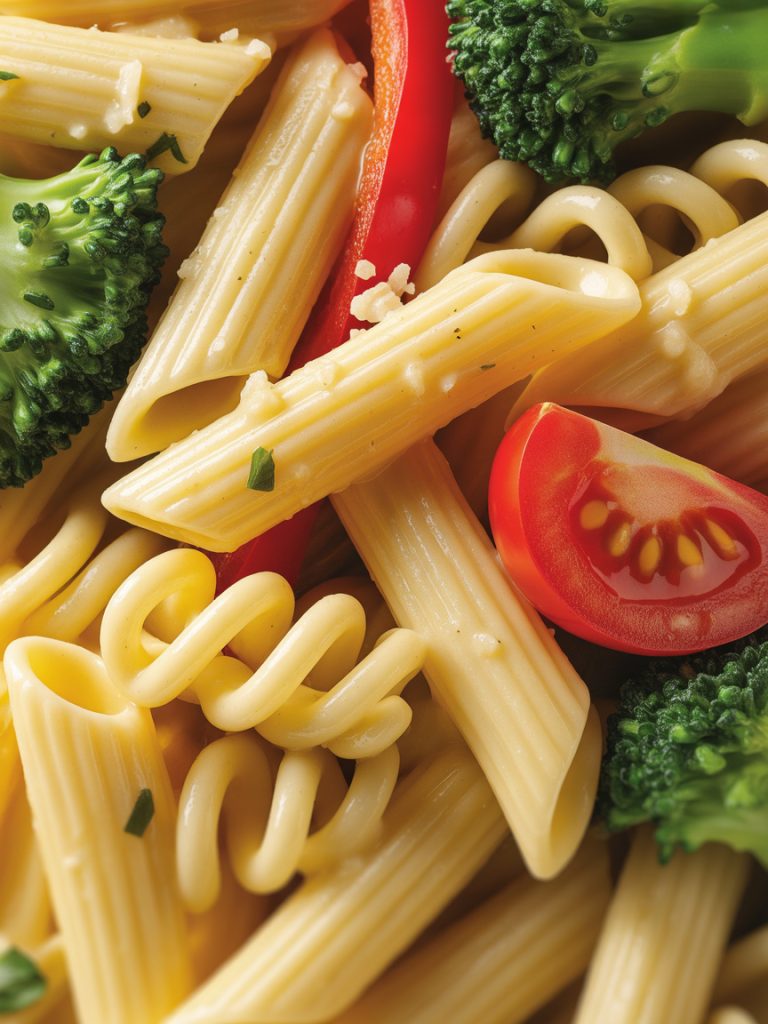
Serving Suggestions
This Pasta Primavera is a complete meal on its own, but here are some ways to round it out or customize it:
Classic Italian Style: Serve with a simple side salad of mixed greens with balsamic vinaigrette and some crusty Italian bread or garlic bread for soaking up any sauce left in the bowl.
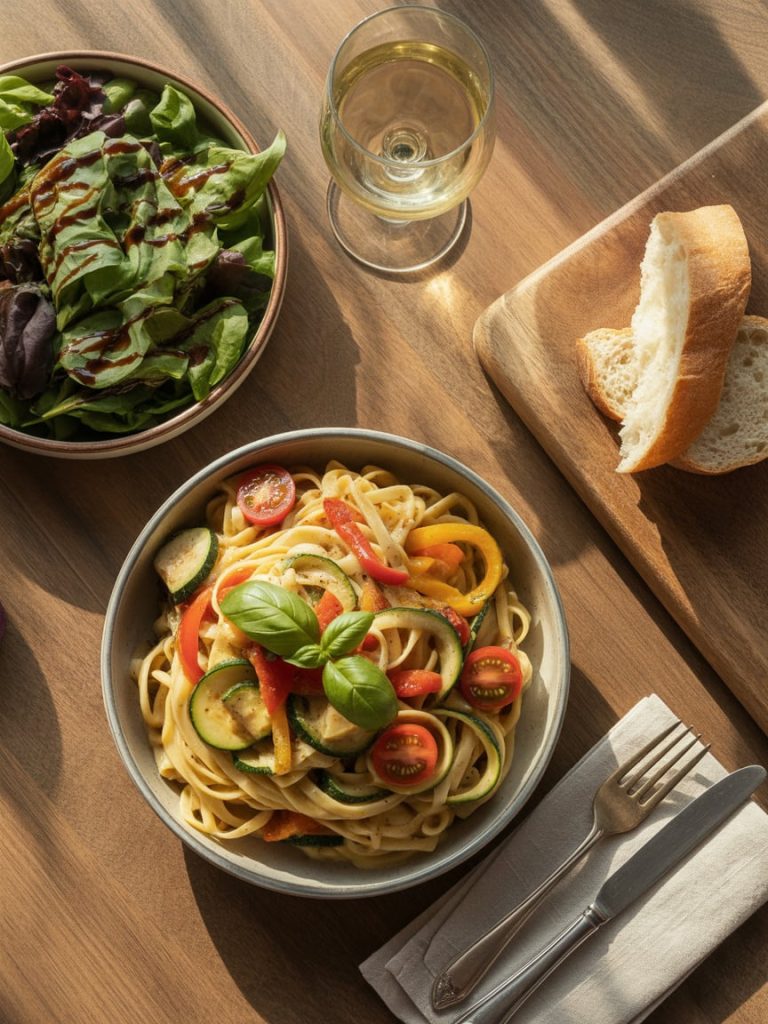
Add Protein: While this is vegetarian as written, you can easily add protein. Grilled chicken, shrimp, or Italian sausage all pair beautifully with primavera. Cook the protein separately and add it when you combine the pasta and vegetables.
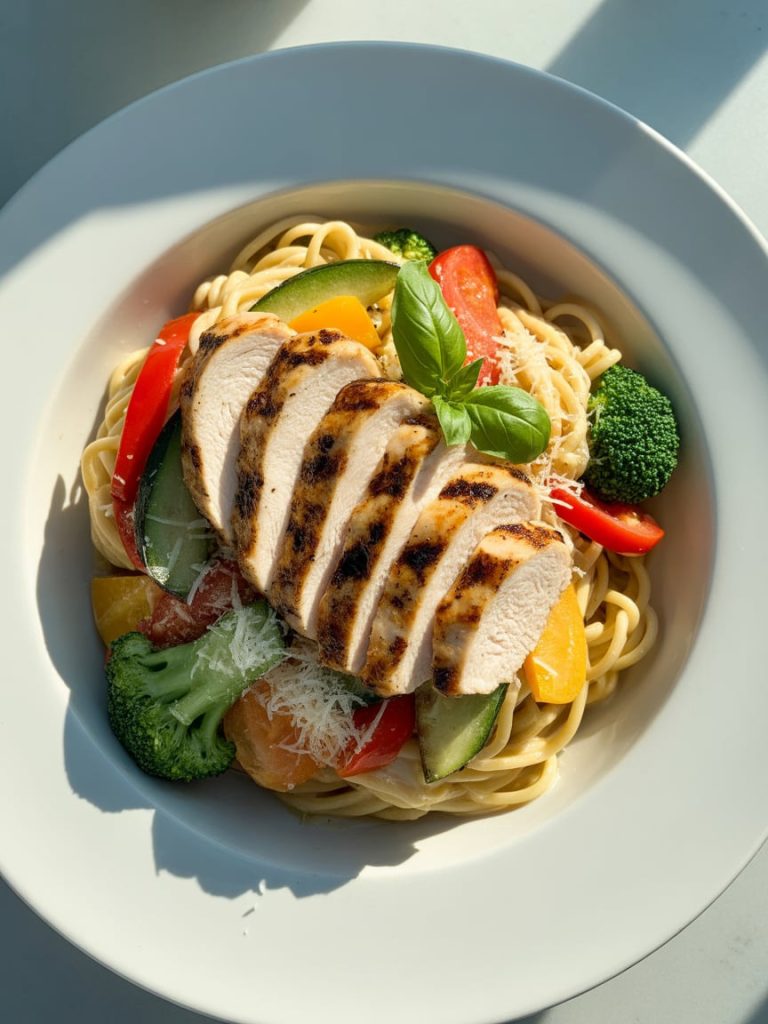
Make it Creamy: Add ½ cup of heavy cream or half-and-half when you add the pasta water for a creamy primavera. It’s richer but still lets the vegetable flavors shine through.

Vegan Version: Skip the butter and parmesan, use all olive oil, and finish with nutritional yeast and extra lemon juice. Add some toasted pine nuts or walnuts for richness.
Cold Pasta Salad: This makes an excellent cold pasta salad for picnics or meal prep. Just toss with a bit more olive oil and lemon juice and serve chilled or at room temperature.
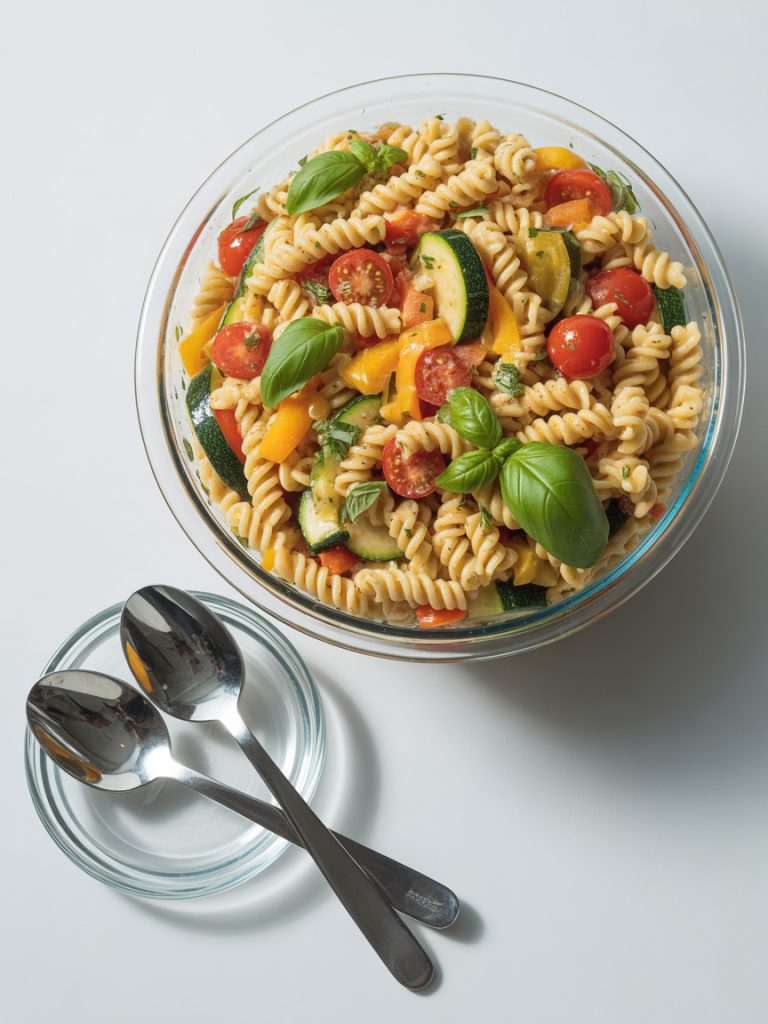
With White Wine Sauce: Deglaze the pan with ½ cup white wine after sautéing the vegetables for a more sophisticated sauce.
Closing
This Pasta Primavera is one of those recipes that makes healthy eating feel easy and enjoyable instead of restrictive and boring. It’s proof that you can pack a meal full of vegetables and have it taste absolutely delicious without relying on heavy cream or excessive cheese. The vegetables stay crisp and vibrant, the pasta provides comfort, and that light lemon-garlic sauce ties everything together perfectly.
I love how adaptable this recipe is. It changes with the seasons, uses whatever vegetables you have available, and never gets boring because it’s different every time based on what you include. That’s the kind of practical, flexible cooking that actually fits into real life and gets made repeatedly.
Whether you’re trying to eat more vegetables, looking for a lighter pasta option, using up produce before it goes bad, or just want something fresh and colorful for dinner, this Pasta Primavera delivers. It’s the kind of meal that makes you feel good—while you’re cooking it, while you’re eating it, and after you’re done.
Give this recipe a try with whatever vegetables look good at your market this week. I have a feeling it’s going to become one of those recipes you make over and over, adapting it each time to whatever’s fresh and available.
Enjoy every colorful, veggie-packed bite! 😊
Pasta Primavera: A Fresh & Healthy Italian Dinner in 30 Minutes
Description
A vibrant Italian pasta dish loaded with fresh seasonal vegetables, garlic, olive oil, and parmesan cheese. This light yet satisfying meal celebrates fresh produce and comes together quickly for an easy weeknight dinner.
Ingredients
Instructions
-
Bring large pot of salted water to boil. Cook pasta according to package directions until al dente. Reserve 1 cup pasta water before draining.
-
While pasta cooks, prep vegetables: Cut broccoli into florets, asparagus into 1-inch pieces, peppers into strips, zucchini into half-moons, tomatoes in half, and mince garlic.
-
Heat olive oil and butter in large skillet over medium-high heat. Add broccoli and asparagus. Sauté 4-5 minutes until crisp-tender.
-
Add bell peppers and zucchini. Cook 3-4 minutes, stirring frequently, until vegetables are tender but still crisp.
-
Reduce heat to medium. Add garlic and cherry tomatoes. Cook 2 minutes, stirring constantly, until garlic is fragrant and tomatoes begin to soften.
-
Add ½ cup pasta water and lemon juice. Simmer 1 minute. Season with salt, pepper, and red pepper flakes if using.
-
Add drained pasta to skillet. Toss everything together with tongs, adding more pasta water as needed to create a light sauce that coats the pasta.
-
Turn off heat. Add parmesan cheese and fresh basil. Toss to combine.
-
Serve immediately with extra parmesan cheese on top.
Note
Vegetable Flexibility: Use whatever vegetables you have or prefer. Green beans, peas, mushrooms, cauliflower, or spinach all work great.
Cooking Order: Add vegetables based on cooking time—hardest first, softest last.
Pasta Water: The starchy water is key to creating a sauce that clings. Don't skip reserving it.
Storage: Store in airtight container for up to 3 days. Reheat gently on stovetop with a splash of water or broth. Best enjoyed fresh.
Make it Vegan: Use all olive oil instead of butter, skip the parmesan or use nutritional yeast.




